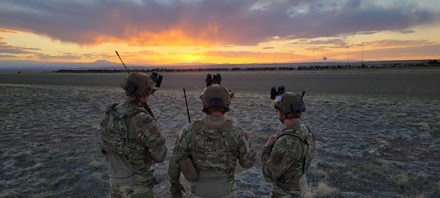
JOINT BASE MCGUIRE-DIX-LAKEHURST, N.J. (AFNS) —
With constant, real-world demands on an aging fleet of aircraft, out-of-the-box thinking is the linchpin for big changes in the way the U. S. Air Force trains its specialized air mobility officers.
Air Mobility Liaison Officers, or AMLOs, are senior Air Force pilots and navigators, hand-selected for training on everything from doctrine and command relationships to the complexities of aircraft landing zone and drop zone operations, radio communications, and the cultural differences between the Air Force, Army, and Marine Corps.
“AMLOs are stationed worldwide,” said Lt. Col. Andrew Baker, Air Mobility Liaison Officer Qualification Course director. “Their mission is to ensure our sister services know how to utilize AMC (Air Mobility Command) airlift to better support their mission. AMLOs eliminate those friction points so the mobility enterprise operates smoothly.”
In order to train others and multiply force capabilities, AMLOs need to be proficient in their specialty. This is done through an intensive eight-week Air Mobility Liaison Officer Qualification Course, or AMLOQC, offered by the USAF Expeditionary Operations School.
The AMLOQC class consists of six weeks of in-class training at Scott Air Force Base, Illinois, followed by two weeks of field training in Colorado. The entire first week in the field, students receive hands-on experience coordinating and communicating with AMC aircraft during takeoff, landing and airlift drops.

Typically, these support aircraft are C-130 Hercules from active duty and Air Reserve Wings using the unit’s own funding. Since these are training missions, any real-world operation that arose had the potential to cancel the mission. Many times, this happened, leaving AMLOQC without aircraft needed for the critical training.
“In a resource-constrained environment, we have to figure out ways that don’t rely on others showing up and spending their own money to support our courses,” said Col. Marcus Cunningham, USAF Expeditionary Center director of operations.
Thinking out of the box in 2019, AMLOQC was able to negotiate with an Air Force Special Operations Command unit and procure an entirely different aircraft: the smaller, lighter AC-208 Combat Caravan.
Since then, the USAF EOS has been working on changing the old way of asking airlift wings to provide aircraft and instead contracting air support. This ensures reliable aircraft support and in-turn, more effective training for the future AMLOs.

In April 2021, this new program was put into place. Two C-130s, a C-145A Combat Coyote, and an AC-208 were used to support AMLOs in their field training. Being smaller and more agile, the C-145 and AC-208 were able to provide five times more landings and takeoffs than a C-130.
“Between ourselves and the C-145, we supported around 20 landings each, which we did within an hour, whereas the C-130 got about six in the hour. We must have done close to 60-70 landings in the three days we were there,” said Brian Hoffmeyer, an AC-208 Combat Caravan load master with the Air Education Training Command, who participated in the new aircraft training at the USAF EOS.
“I was in awe of how much training we got this time around compared to what I saw a couple years ago,” Baker, who explained that students previously only had a couple of chances to coordinate aircraft, said.
“Now, if you make a mistake with your first call, you get another nine chances to make it right,” Baker continued. “It’s good because the students can go out into their operating locations after they’ve moved on from our training and feel more confident. Whether you’re controlling a C-130 or an AC-208, the procedures and communications are exactly the same.”

C-130s and C-17 Globemaster IIIs are still necessary for moving large amounts of cargo, equipment, and personnel worldwide and AMLOs will continue to be trained to work with these grey tail aircraft. However, smaller and more mobile aircraft can support troops at a lower scale when flexibility and speed are key.
“An AC-208 isn’t going to keep an entire base alive for 24 hours, but for forward operating bases and combat outposts, it does just fine,” Hoffmeyer said.
Positive remarks have been flowing into Cunningham’s office about the course change.
“This was a proof of concept for using a AC-208 to do forward support and it went lovely,” Cunningham said. “When you cooperate and you do things differently, it can sometimes lead to a better way of doing business.”
AMLOQC just graduated its latest batch of AMLOs last week and the AC-208 was right there with them as they did their field week of training. Using the AC-208 over the past few AMLO courses has proven the worth of trying something a little out of the box.
The USAF EOS, part of the U.S. Air Force Expeditionary Center, develops and delivers expeditionary training and education for the Air Force. Its mission is to train and educate total force Airmen for a broad spectrum of expeditionary operations today and tomorrow.
By SSgt Sarah Brice, U.S. Air Force Expeditionary Center Public Affairs

